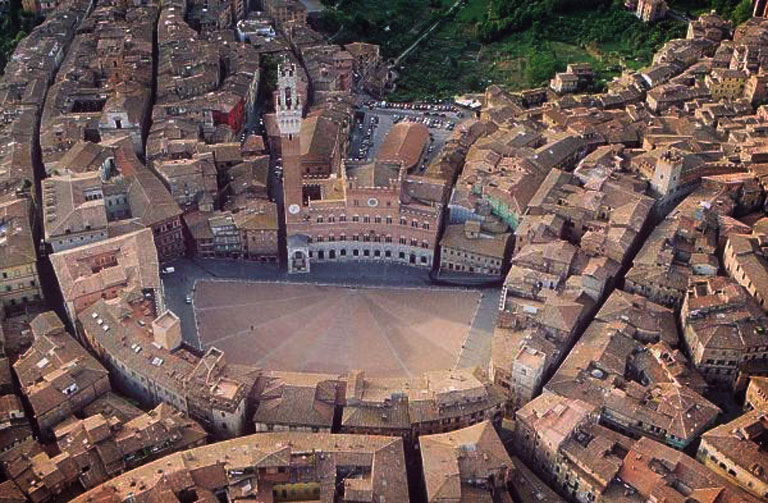Arte e cultura
Siena: history, art and breath-taking landscapes


History, art, landscapes; a magnificent urban design of the Middle Ages; the famous palio: these are the distinctive elements of Siena, which is only second to Florence as for beauty among the Tuscan cities. It is not by chance that in 1995 its historic center was given the title of World Heritage by Unesco. It was first an Etruscan, then a Roman city, at last a medieval Commune troubled by fierce struggles, wars, pestilences and invasions. It finally fell under the dominion of the Medici.
Some advice: go straightaway, as soon as you arrive, to the shell-shaped Piazza del Campo, where eleven streets join. This square has represented the center of the city throughout the centuries, dominated by the biggest Gothic building in Tuscany: the Palazzo Pubblico (1298) made of stones and bricks, with the slim Torre del Mangia (1349). Architecture, sculpture and painting will compete for your interest, but special attention is to be given to the Palazzo Pubblico, which hosts two amazing masterpieces of Italian painting: the Maestà (1315) and the imaginative Portrait of Guidoriccio da Fogliano (1328) by Simone Martini, and the largest medieval cycle of paintings on a secular subject: The Good Government by Ambrogio Lorenzetti (1338).
Let yourself be fascinated from the very first moment by the architecture of Siena’s peculiar medieval streets; then you’ll have the time to concentrate on its marvelous Museums, starting from the Pinacoteca located in Palazzo Bonsignori, which you can reach from the square after going along the beautiful and lively via di Città and then the via di San Pietro. From the rich art gallery you can go as far as Santa Maria del Carmine, a fourteenth-century church hosting some important works of art, and from there, through the streets Peruzzi e Stalloreggi, reach the huge monumental complex of the Cathedral and Baptistery.
The Cathedral is one of the most remarkable Gothic buildings in Italy. The core part of the present church was built between 1196 and 1215, whereas a fabulous enlargement, which had been planned, was interrupted due to the pestilence of 1348, which prostrated the city. A remain of this amazing architectural dream is the impressive unfinished wall. It is difficult to choose among the wonders of the Cathedral of Siena: from the Pulpit sculpted by Nicola Pisano to the floor with marble marquetry to the monumental Piccolomini Altarpiece and the Frescos by Pinturicchio in the Piccolomini Library, it is a matchless adventure throughout centuries and schools of Italian art. Another important Museum is that of the Opera del Duomo, alongside of the Cathedral, with the Tre Grazie, a graceful sculpture which is a Roman copy of a Hellenic original, and the magnificent Maestà by Duccio di Buoninsegna (1311).
From the Cathedral, go along the picturesque via Galluzza towards the majestic Gothic basilica di San Domenico with its crenellated campanile (inside there are beautiful frescos portraying Santa Caterina by Andrea Vanni); go past the fine Casa di Santa Caterina, the saint’s house transformed into a church in the XV century, and along the via delle Terme towards the Palazzo Salimbeni, with its beautiful Gothic windows with three lights, then, from there, along via dei Rossi to the magnificent Chiesa di San Francesco (1326-1475) with important frescos by the Lorenzetti. From San Francesco go past the fifteenth-century Oratorio di San Bernardino and you will have the chance to come back to via dei Rossi, so as to admire, in via Banchi di Sopra, the Palazzo Tolomei (XIII century), the most beautiful private building of medieval Tuscany.
From there, if you go as far as the Piazza del Campo, you will reach the elegant Loggia della Mercanzia and, once you have entered via Banchi di Sotto, admire the Palazzo Piccolomini and, just a while after, the thin fifteenth-century Loggia del Papa, next to the Chiesa di San Martino. If you go further along via San Martino, you will reach another remarkable church: Santa Maria dei Servi, in a romantic isolated position among cypresses, with innumerable precious works of Sienese painting.
We don’t have the illusion that we have described all Siena: the traveler who is not too much in a hurry will be able to discover many other beauties, visit the Archeological and Etruscan Museum located in Palazzo Sansedoni, make the interesting tour of the Porte, that is the gates of the city, as well as venture as far as the environs, the Convento dell'Osservanza, or the Castello di Belcaro.
events
-
20September
Picasso and Spanish Modernity From 20th September 2014 to 25th January 2015 -
29October
The Chamber Musicians of “Maggio Musicale Fiorentino” 29th October 2014 -
13November
Women as Protagonists of the 20th Century from 13rd November 2013
